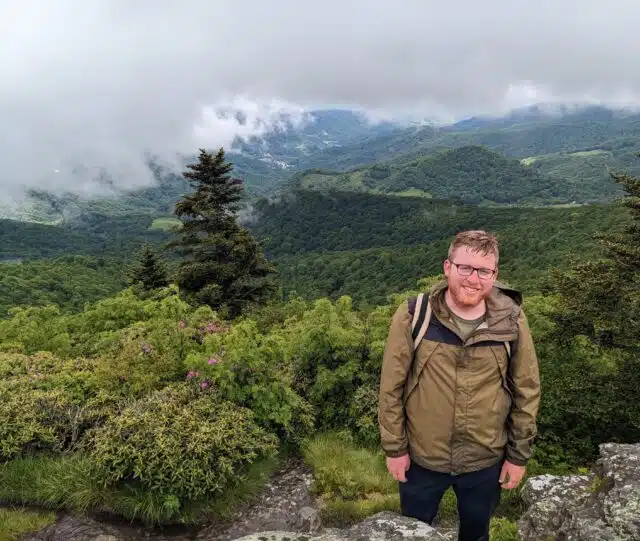
Grafting is an ancient technique of joining two distinct plants together. Grafts occur naturally or they can occur through human intervention. In practice, grafting usually involves the joining of the shoots of one plant (termed the “scion”) to the roots of another (termed the “rootstock” or “understock”).
In ornamental horticulture, some of the most recognizable plants are grafted. The redbud you purchased at your local garden center is grafted. Your favorite Japanese maple is grafted. The weeping cherry tree in your front yard is grafted. Food crops like apples, cherries, and grapes are also grafted.
The reasons for grafting some ornamental plants instead of utilizing other types of propagation are numerous, but the prevailing reason is that some ornamental plants are hard to propagate by other means. Seed may be hard to germinate. Stem cuttings may be hard to root. Grafting allows you to fuse a specific scion to any compatible rootstock.
One group of plants for which grafting has not caught on in the United States is rhododendrons. As part of the work we’re doing at Holden’s David G. Leach Research Station, we are interested in rootstocks as a potential means of improving Rhododendron success in the landscape. Centuries of Rhododendron hybridizing have yielded amazingly ornamental plants. Problems arise when these plants are put into adverse soil conditions, such as poorly draining soils or disease pressure. We think grafting these otherwise beautiful rhododendrons onto adapted rootstocks can be a solution to some of these problems.

Photos 1 and 2. A freshly made but unrooted Rhododendron graft (left) and a successful, rooted graft (right). When we graft rhododendrons, we graft the scion to the rootstock and induce roots to form on the rootstock at the same time. This technique is called cutting-grafting or stenting.
One of David Leach’s most successful Rhododendron introductions is a yellow-flowered hybrid called ‘Capistrano’. Despite its commercial success, homeowners often find its performance to be poor – some have suggested ‘Crapistrano’ is a more apt name. Aside from these performance issues, it’s an attractive plant – one of the best cold hardy, yellow-flowered rhododendrons for our region.

David Leach’s Rhododendron ‘Capistrano’, a beautiful but finicky selection for our region.
Now retired Leach Station director Steve Krebs started a project a few years ago to investigate the benefits of grafting rhododendrons, and the results are profound. At our Lower Baldwin research site at Holden Arboretum, Steve and Leach Station Field Specialist Jing Wang planted pairs of ‘Capistrano’ consisting of one on its own roots and one grafted onto a highly adaptable rootstock called Inkarho® Lakeview Pink. Now, several years later, all of the non-grafted ‘Capistrano’ have died, while most of the grafted ones are thriving.

‘Capistrano’ on its own roots (left) and grafted onto Inkarho® Lakeview Pink (right). On its own roots, ‘Capistrano’ succumbs to root diseases in open field conditions at Holden’s Lower Baldwin field site. When grafted onto Inkarho® Lakeview Pink, it thrives.
Now we’re moving beyond Inkarho® Lakeview Pink. Is this the best rootstock to use, or are there better ones? The standard rootstock in Europe is a plant called ‘Cunningham’s White’. It is a nice plant in its own right but has gained fame for its use as a rootstock. In the Layer Garden at Holden Arboretum, there is a ‘Cunningham’s White’ growing along the path just beyond the Murch Canopy Walk. It tends to lightly bloom in fall in addition to its spring bloom.
The breeding program at the Leach Station has produced numerous plants resistant to root rot, a disease that makes it challenging to grow rhododendrons. Might one of these plants make a good rootstock? Or maybe another old-timer Rhododendron that has proven itself in local landscapes would make a good choice. In the same bed in the Layer Garden as ‘Cunningham’s White’ is a plant called ‘English Roseum’. This plant has been shown to be root rot resistant and is highly vigorous grower in our greenhouses.
We are currently evaluating several potential rootstocks including Inkarho® Lakeview Pink, ‘English Roseum’, and several Leach Station hybrids, and we hope to report on our top choices in several years. Rhododendrons are tough to grow and I think always will be in our region. But we’re convinced adapted rootstocks help and will keep advocating for their use. Keep an eye out for grafted rhododendrons available at future Holden plant sales.

Connor Ryan, MS
Rhododendron Collections Manager
My group is engaged in three things at Holden: curating the Rhododendron collection, breeding landscape plants, and stewarding the David G. Leach Research Station. Current collections focuses include North American native rhododendrons and azaleas, especially R. flammeum, R. prunifolium, and the Ohio natives, as well as any non-native species that may be adapted to our climate. Breeding focuses are on broader adaptability in elepidote rhododendrons, reblooming in evergreen azaleas, and a few smaller projects with Pieris and Hamamelis. We strongly believe in the value of living collections and are happy to share non-proprietary germplasm or accommodate collections-based scholarship. If you work for a botanical garden or nursery interested in rhododendrons (or azaleas) or are a scholar studying them, please get in touch. We would love to help with your work.












